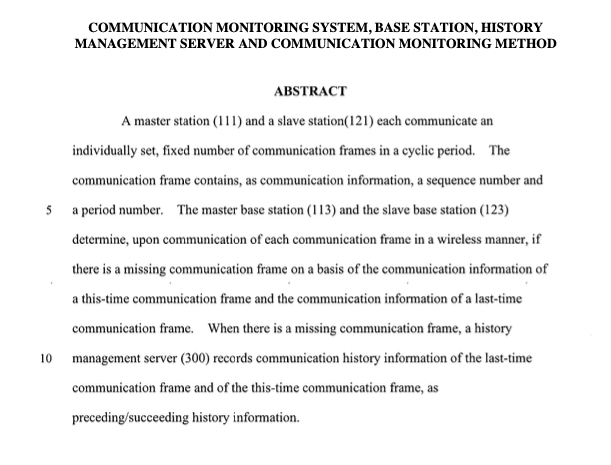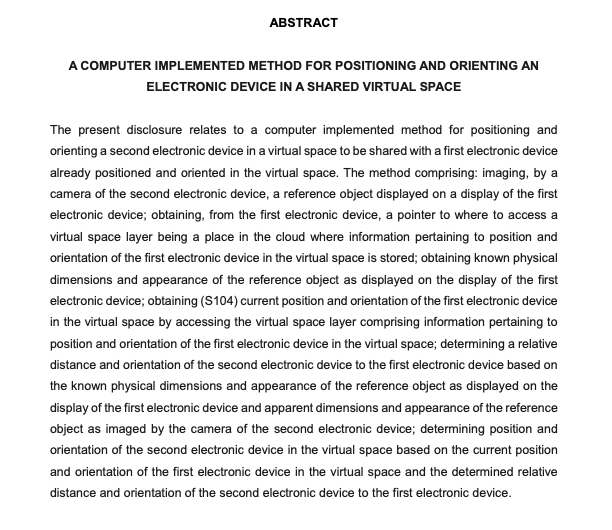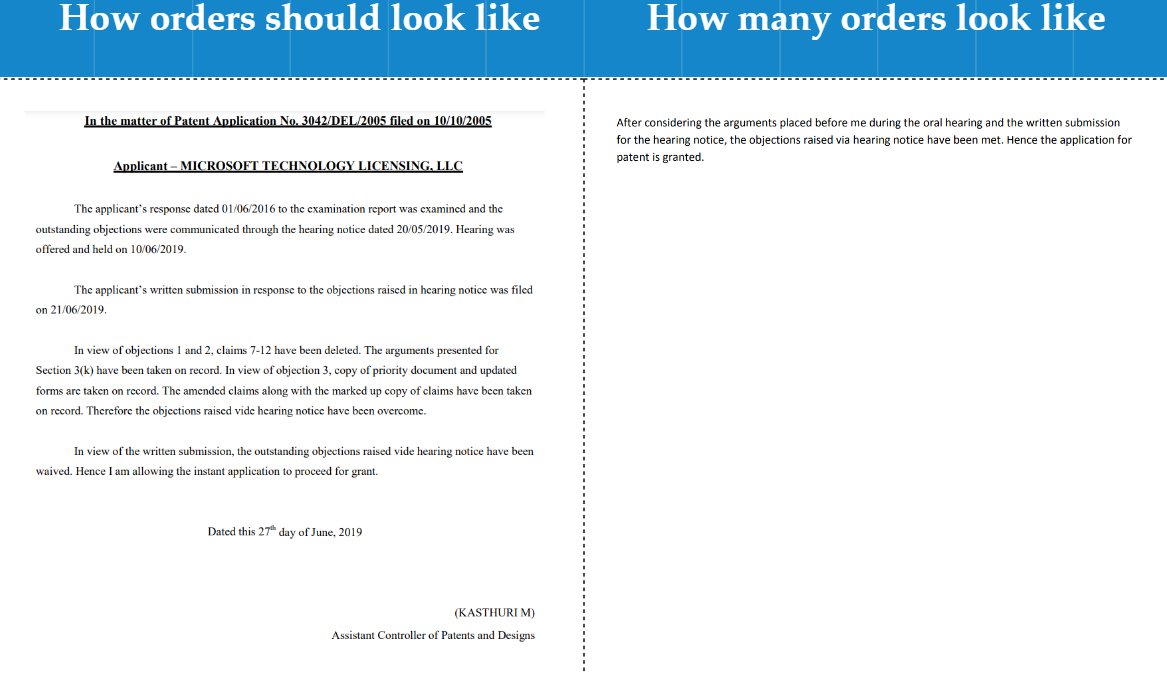Software Patents Review #1 dated 15/01/2024
For the purpose of this review we checked for patents filed from 01/12/2023 till 12/01/2024 at the https://iprsearch.ipindia.gov.in website. A search from granted patents returned zero results whil
For the purpose of this review we checked for patents filed from 01/12/2023 till 12/01/2024 at the https://iprsearch.ipindia.gov.in website. A search from granted patents returned zero results while a search for published patents returned 1,437 results. A quick search indicated that most of the published patents seem to be software patents. Note that these are patents that are published but not yet granted by the Indian Patent Office (IPO).
We then reviewed this against Section 3(k) of the Indian Patents Act which states that, “mathematics, business methods, computer programs per se, and algorithms” are not patentable subject matter. As per FOSS United's submissions to the Indian Patent Office, we also evaluated some of the patents against the three part test that we believe to be the right way to evaluate “computer programmes per se.” This three part test was a part of the 2015 Computer Related Inventions guidelines that was published by IPO in 2015, but was subsequently removed from the next version of the guidelines that are currently in force.
The three part test read as follows:
Tests/Indicators to determine Patentability of CRIs:
Examiners may rely on the following three stage test in examining CRI applications:
Properly construe the claim and identify the actual contribution;
If the contribution lies only in mathematical method, business method or algorithm, deny the claim;
If the contribution lies in the field of computer programme, check whether it is claimed in conjunction with a novel hardware and proceed to other steps to determine patentability with respect to the invention. The computer programme in itself is never patentable. If the contribution lies solely in the computer programme, deny the claim. If the contribution lies in both the computer programme as well as hardware, proceed to other steps of patentability.
NOTE: Those interested in understanding Section 3(k) and its changing interpretations in the Patent Manual should read the Software Freedom Law Center (SFLC) India‘s report titled, Software Patents in India: Law and Practice.
Given limitations of time, we obviously could not review each and every patent. However, a quick look at the headings of the patents indicated that 60 percent or more of the patent applications published by the IPO pertain to software. Some of the patents are plain method patents, untethered to any innovative hardware, as can be seen from Patent Application Number 202347085943 from Mitsubishi Electric Corporation and Patent Application Number 202347085847 from Auki Labs AG.
Patent Application Number 202347085943 from Mitsubishi Electric Corporation

Patent Application Number 202347085847 from Auki Labs AG.

On going through these patents, I had a number of observations.
Firstly, I have an appreciation for patent examiners who have to wade through these applications. I assume that the current guidelines are way more challenging to apply as compared to the clear cut, three-part test.
Secondly, I felt a deep sense of sorrow at India’s policy making & implementation capabilities because the gap between what was intended by the Indian parliament, and what is happening on the ground is so vast. Section 3(k) of the Indian Patents Act says that, “a mathematical or business method or a computer programme per se or algorithms,” are not patentable subject matter. Delivering into the legislative history of Section 3(k), the SFLC report says, “Thus, computer programmes per se along with mathematical methods, business methods and algorithms were excluded from the list of patentable subject matter. The words per se are attached only to computer programmes, and not to the other terms in the clause. ‘Per se’ has been defined by Black’s Law Dictionary to mean ‘by itself’. The Act therefore stated that computer programmes by themselves were not patentable. The Joint Parliamentary Committee Report, 2002 stated in this regard that“... sometimes the computer program may include certain other things, ancillary thereto or developed thereon. The intention here is not to reject them for grant of patent if they are inventions. However, the computer programs as such are not intended to be granted patent.”
The software per se confusion
In 2005, the Patent Amendment Act sought to introduce software patents. The language proposed for Section 3(k) was,
(k) a computer programme per se other than its technical application to industry or a combination with hardware;
(ka) a mathematical method or a business method or algorithms.”
Since all computer programmes have technical effects and work in combination with hardware, this amendment (if approved) would have turned software into a patentable subject matter in India. However, this amendment was rejected by the Indian Parliament, which chose to retain Section 3(k) as it currently stands.
Explaining the reasons for this, Shri Kamal Nath, the then Minister of Commerce & Industry, when introducing the Bill in the Lok Sabha and Rajya Sabha on 23rd March, 2005 said that, “It is proposed to omit the clarification relating to patenting of software related inventions introduced by the Ordinance as Section 3(k) and 3 (ka). The clarification was objected to on the ground that this may give rise to monopoly of multinationals.”
Against this backdrop, the Indian Patent Office introduced its Draft Patent Manual in 2008. Astonishingly, it sought to make technical applications of software patentable! The relevant section of the 2008 Draft said:
Draft Manual 4.11.7
4.A mathematical method is one which is carried out on numbers and provides a result in numerical form (the mathematical method or algorithm therefore being merely an abstract concept prescribing how to operate on the numbers) and not patentable. However, its application may well be patentable, for example, in Vicom/Computer-related invention [1987] 1 OJEPO 14 (T208/84) the invention concerned a mathematical method for manipulating data representing an image, leading to an enhanced digital image. Claims to a method of digitally filtering data performed on a conventional general purpose computer were rejected, since those claims were held to define an abstract concept not distinguished from a mathematical method. However, claims to a method of image processing which used the mathematical method to operate on numbers representing an image can be allowed. The reasoning was that the image processing performed was a technical (i.e. non- excluded) process which related to technical quality of the image and that a claim directed to a technical process in which the method used does not seek protection for the mathematical method as such. Therefore the allowable claims as such went beyond a mathematical method. [emphasis ours].
The All India People’s Science Network pointed out in their letter that the above section was lifted from Clause 1.17 of the UK Patent Manual. Thus, the DPM completely went against the will of the Indian parliament and sought to bring in software patents through the back door. That a subordinate institution contradicted the will of the highest law making body in the country is a matter of grave concern.
Upon protest from the Free and Open Source Software (FOSS) community in India, the DPM was revised in 2010 and stated that, “‘Mathematical methods, business methods, computer programmes per se and algorithms are not considered as patentable inventions’.” Pushback from MNCs resulted in the section on software patents in the DPM being revised again in 2011 to read, “Mathematical methods, business methods and algorithms claimed in any form, are not patentable….If the claims, inter alia, contain subject matter which is not computer programme, it is to be examined whether such subject matter is sufficiently disclosed in the specification and forms an essential part of invention.”
Unfortunately, despite the clear legislative history, the interpretation of Section 3(k) has been a see-saw battle between the FOSS community on one hand, and MNCs and large companies, on the other hand. As a result, the Computer Related Inventions guidelines were modified again in 2013, 2015 and 2019 with varying impact on patentability of software.
A study commissioned by FOSS United, and researched by Software Freedom Law Center found that the IPO has been granting patents on software, with most of these patent grants going to MNCs. This contravenes what the then Minister, Mr Kamal Nath had said about the proposed 2005 amendment to Section 3(k) being modified, “on the ground that this may give rise to monopoly of multinationals.”

To compound the problem, many of the patent grants lack any real reasoning, are unsigned, and do not even mention the application number or any other identifier. It looks somewhat like this:

It must be noted that the CRI Guidelines/DPM lack the force of law as pointed out by former Supreme Court Justice VR Krishna Iyer. Therefore, patents granted by the IPO for software could be invalidated on the grounds that they have been granted in violation of the will of the Indian Parliament. This is a mishap waiting to happen and could lay waste the time and effort invested by applicants in obtaining software patents. The only players who profit will be patent lawyers, while industry and society deals with the negative consequences of patent litigation.
Negative Consequences of Software Patents
To be sure, the two examples cited above are just patent applications and not granted patents. However, as we have seen from the SFLC report, the number of software patents being granted in India is rising. The bulk of these patent grants are going to MNCs, though the percentage of Indian grantees is also rising. Whether the grantees are Indian or foreign entities, there are multiple challenges involved.
Patents are state granted monopolies for a period of 20 years, in return for disclosure of an idea. This grant provides the inventor exclusive rights to the patented process, design, or invention for a designated period in exchange for a comprehensive disclosure of the invention. During the industrial age, many inventors took their inventions to the grave because these inventions were protected as trade secrets. When the inventors died, very few knew how to operate these inventions. The original intent of the term limit was to ensure that the invention becomes part of the commons once the patent expires, instead of trade secrets that vanish with their inventors.
As the industrial age changed into the information age, the landscape of innovation has changed dramatically. In the software sector that defines the information age, the Free and Open Source (FOSS) model of Collaborative Innovation, based on collaboration, community and the shared ownership of knowledge, is the dominant paradigm. Instead of hoarding ideas as trade secrets, software developers voluntarily share their source code with others over the Internet, and form communities that collaborate and rapidly develop new technologies. The FOSS model of Collaborative Innovation drives all emerging technologies from cloud computing, distributed computing, big data and analytics, and many others. The Linux Foundation, a leading FOSS organization that hosts 300+ FOSS projects, estimates that these projects have created 1.15 billion lines of code worth $54 billion. Similarly, the Apache Software Foundation estimates that the 350+ projects it hosts have created FOSS worth $22 billion.
Our modern digital world would be unimaginable without FOSS. As digital public goods that are non-rivalrous and non-excludable, FOSS represents a wealth of technologies that can be used, modified, improved and shared by anyone for free. From stock exchanges to social media to search engines to supercomputers to the Mars Rover to airline scheduling to pandemic predictions, FOSS touches every aspect of our lives.
From a policy perspective, software patents are the opposite of the Collaborative Innovation model. A patent grant is a first-past-the-post system that gives an individual or corporation owning the patent the ability to prevent others from using similar techniques, even if they have arrived at it independently. Imagine if Edmund Hillary and Tenzing Norgay who first climbed Everest had the ability to prevent others from touching the summit, or collect tolls from other mountaineers for the right to touch the summit. In a world where people voluntarily share their code and collaborate with others, the need for incentivising disclosure with a 20 year monopoly is counterproductive and can harm Collaborative Innovation. It is time to update the Patents Act from the industrial age to the information age, and comprehensively stop handing out 20 year monopolies in the form of software patents.
No comments yet. Login to start a new discussion Start a new discussion